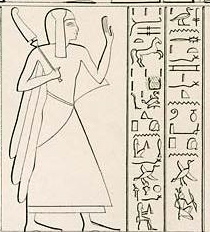Life
Pareherwenemef was present at the Battle of Kadesh and is depicted in the Abu Simbel temple. [2] In the Kadesh inscriptions an incident is mentioned where two Hittite spies are captured. The interrogation reveals that the enemy is much closer than previously thought. The royal family quickly fled to the west, away from danger, led by Prince Pareherwenemef. The prince was called "First Brave of the Army" and later became "Superintendent of the Horse". Eventually Pareherwenemef became First Charioteer of His Majesty, a position he shared with his brother Mentu-her-khepeshef. [1]
Among the sons of Ramesses II, Pareherwenemef received the highest military honors. He held numerous titles, including “Great General of the Army,” “Leader of the King’s Army,” “First of the Braves,” “First Deputy of the Army,” “Overseer of Horses,” and “First Charioteer of His Person.” [3]
Pareherwenemef is depicted on the facade of the small temple at Abu Simbel. [2] He also appears on the palace facade in the Ramesseum. A statue base from Karnak mentions Pareherwenemef. On that same base a woman named Wadjyt-khati is mentioned but her exact relation to the prince is not known. [4]
He predeceased his elder brother Amunherkhepeshef, and there is no evidence that he lived beyond the 20th year of Ramesses II’s reign. Shortly thereafter, Nefertari’s youngest son, Meryatum, assumed the title “Eldest King’s Son,” indicating that he had become the eldest living son of his mother. Meryatum is believed to have died during the 46th to 52nd year of Ramesses II’s reign, and based on records of the succession of the High Priest of Ra, his death likely occurred in the earlier part of this period. [5]
This page is based on this
Wikipedia article Text is available under the
CC BY-SA 4.0 license; additional terms may apply.
Images, videos and audio are available under their respective licenses.
